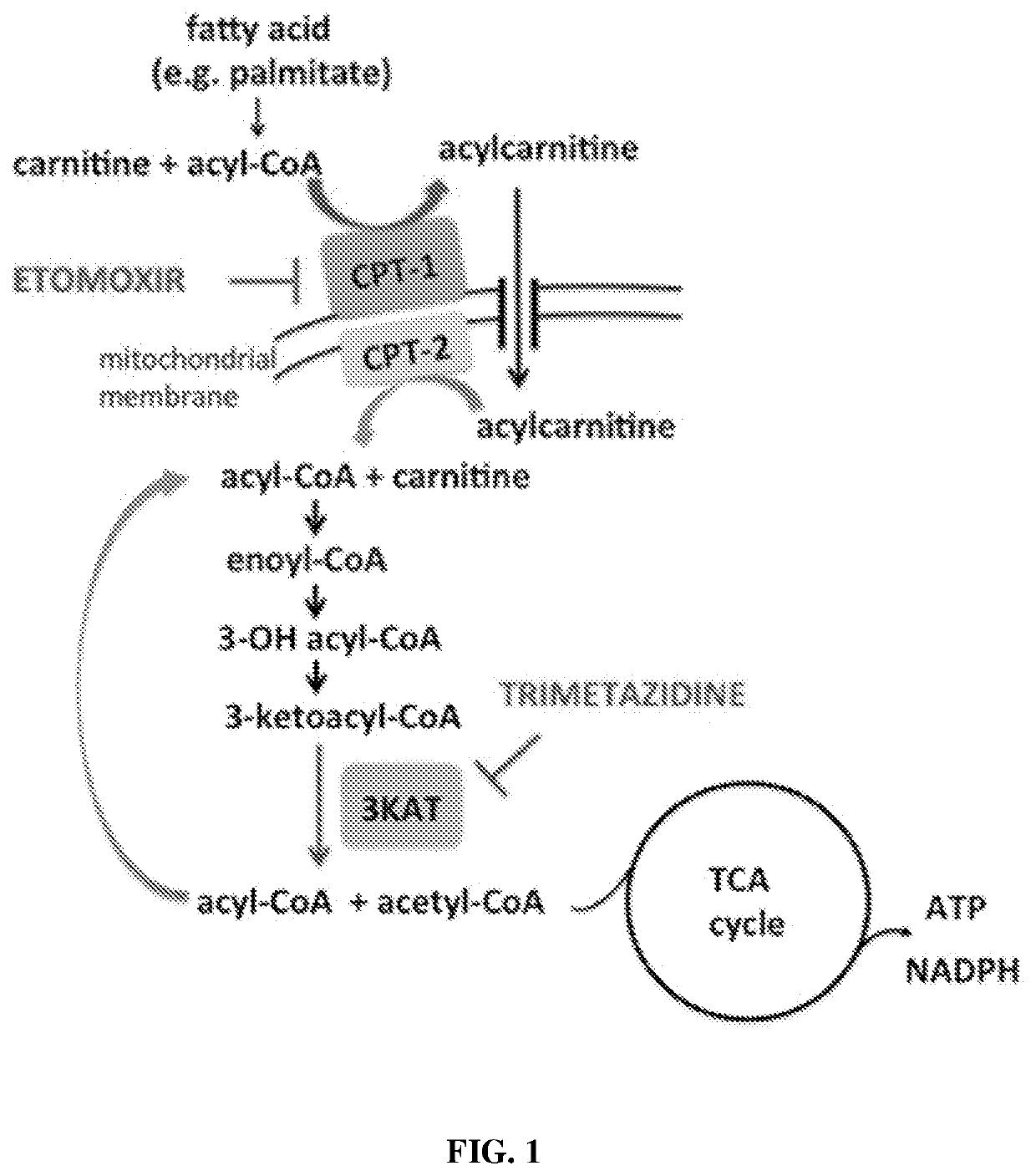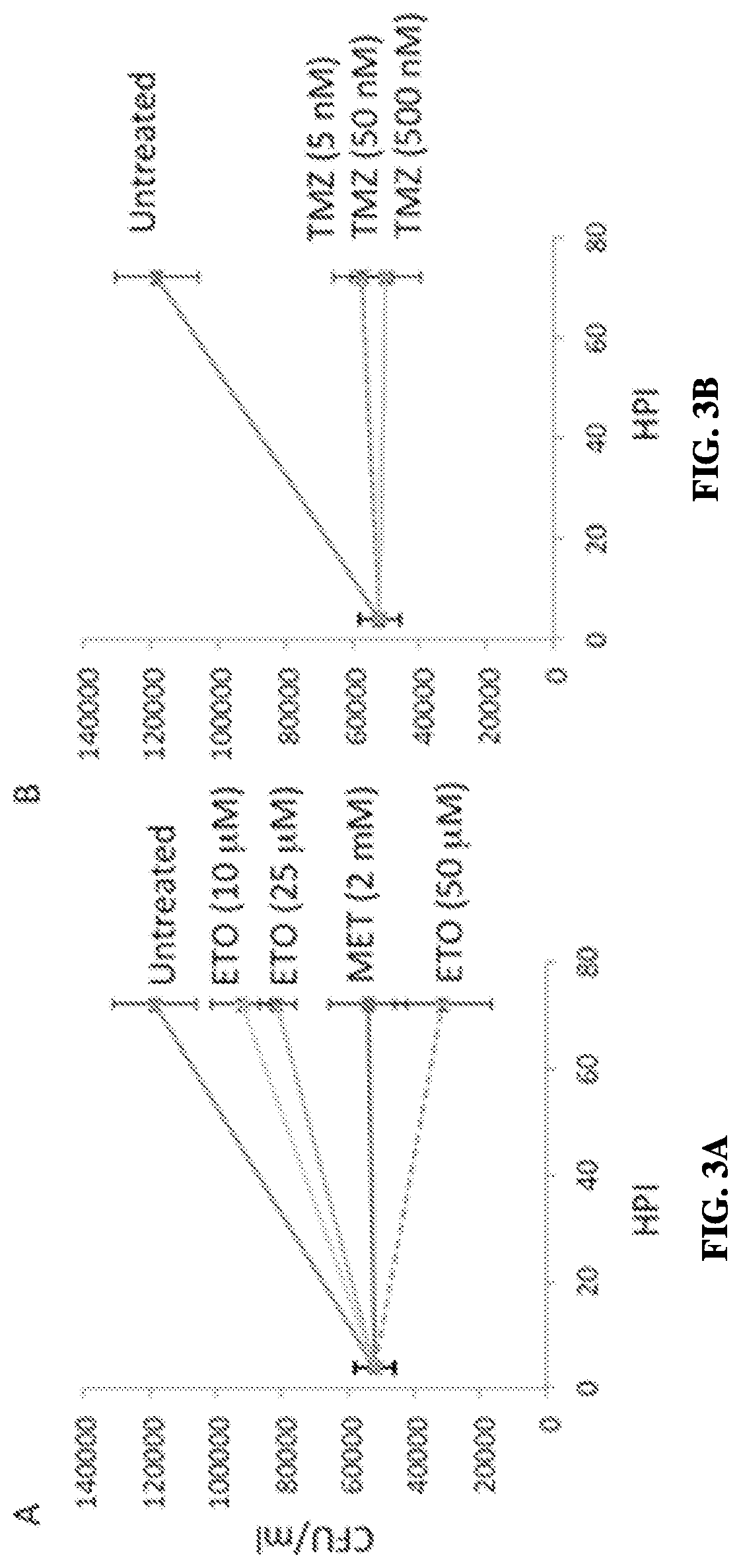Use of fatty acid oxidation inhibitors as antimicrobials
- Summary
- Abstract
- Description
- Claims
- Application Information
AI Technical Summary
Benefits of technology
Problems solved by technology
Method used
Image
Examples
example 1
[0039]In this Example, the relationship between FAO inhibition and intracellular Mtb growth was analyzed.
[0040]Mtb-infected macrophages were treated with 10, 25, or 50 μM etomoxir, concentrations that inhibit macrophage FAO. Mtb viability was assayed 72 hours post-infection (hpi) by plating for colony forming units (CFU; FIG. 3A). Etomoxir exhibited a dose dependent inhibition of Mtb. Etomoxir did not directly prevent Mtb growth, even at ten times the dose that inhibited intracellular Mtb (Table 1). The absence of direct antibacterial activity suggests that etomoxir acts on a host target.
TABLE 1MIC on Mtb (H37Rv) in liquidDrugMICEtomoxir>250μMPerhexiline>100μMOxfenicine>140mMTrimetazidine1mMMetformin>15mMINHμM
[0041]To determine whether antibacterial activity was specific for etomoxir and CPT-1 inhibition, the antimicrobial activity of trimetazidine (TMZ), which inhibits FAO by blocking long-chain 3-KAT, was then determined. Remarkably, it was found that concentrations as low as 5 nM...
example 2
[0043]In this example, the minimal inhibitory concentration (MIC) of the FAO inhibitors, etomoxir and trimetazidine on mycobacteria inside of macrophages was determined and compared to their inhibition of FAO.
[0044]If CPT-1 and 3-KAT are the relevant antimicrobial targets, respectively, concordance in the potency of the compounds is anticipated in the assays. Previous studies found that FAO is blocked in murine and human monocyte-derived macrophages by 10-25 μM etomoxir, concentrations that exhibit antimycobacterial activity. The antimycobacterial MIC of trimetazidine was 5 nM in murine macrophages. The MIC of TMZ against Mtb in human THP1 cells was approximately 50 nm. The ability to inhibit Mtb growth at nM concentrations is consistent with an on-target effect, as TMZ inhibits long-chain 3-KAT activity in rat heart mitochondria at doses between about 10 nM and about 100 nM (IC50˜75 nM).
[0045]The antimicrobial activity and FAO inhibition was analyzed for cellular toxicity. BMDMs we...
example 3
[0046]In this Example, the antibacterial activity of FAO inhibitors and its dependence upon known host targets was evaluated.
[0047]There are three isoforms of Cpt-1. Cpt-1a is expressed in most tissues, whereas Cpt-1b and Cpt-1c are restricted to muscle and brain, respectively. 3-KAT is a component of the mitochondrial trifunctional protein. The β-subunit (HADHB) catalyzes the thiolase activity.
[0048]Bone marrow stem cells from Cpt-2flox / flox LysM-Cre+ mice were obtained. Although Cpt-2 is not the direct target of either etomoxir or trimetazidine, it is required in the same pathway (FIG. 1). Accordingly, the activity of etomoxir and trimetazidine was evaluated in Cpt-2 mutant cells as compared to wild type (wt) cells using the assays described above. The activity of etomoxir and trimetazidine was compared to the activity of metformin in these cells. Results are shown in FIGS. 5A & 5B. The antimicrobial activity of etomoxir and trimetazidine depended upon Cpt2, consistent with their ...
PUM
| Property | Measurement | Unit |
|---|---|---|
| Molar density | aaaaa | aaaaa |
| Molar density | aaaaa | aaaaa |
| Molar density | aaaaa | aaaaa |
Abstract
Description
Claims
Application Information
 Login to View More
Login to View More - R&D Engineer
- R&D Manager
- IP Professional
- Industry Leading Data Capabilities
- Powerful AI technology
- Patent DNA Extraction
Browse by: Latest US Patents, China's latest patents, Technical Efficacy Thesaurus, Application Domain, Technology Topic, Popular Technical Reports.
© 2024 PatSnap. All rights reserved.Legal|Privacy policy|Modern Slavery Act Transparency Statement|Sitemap|About US| Contact US: help@patsnap.com










